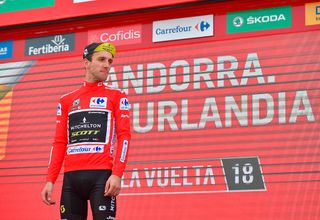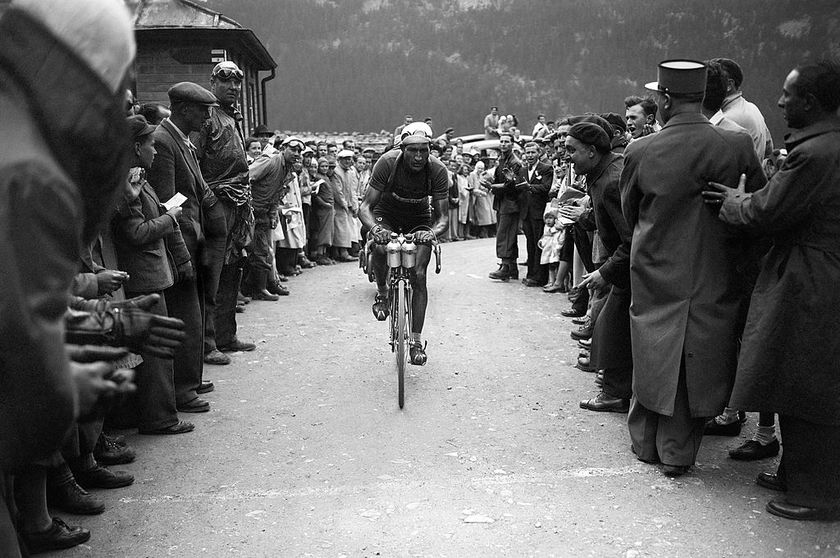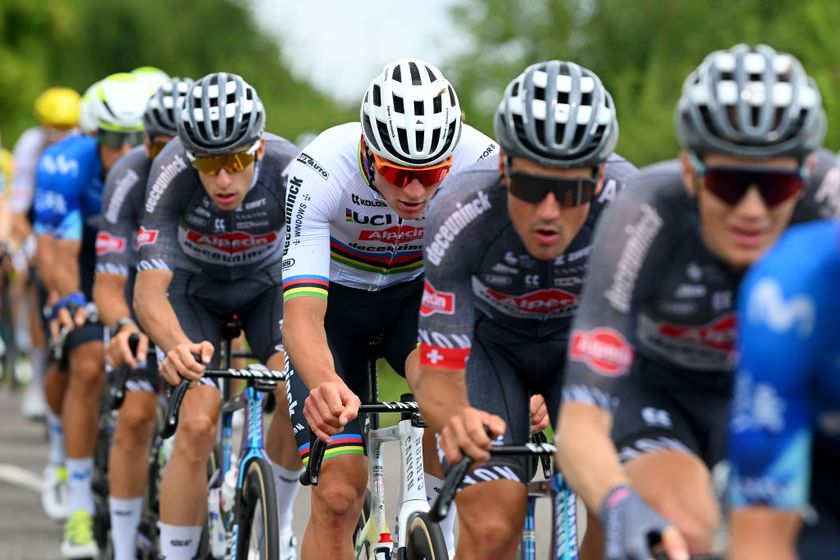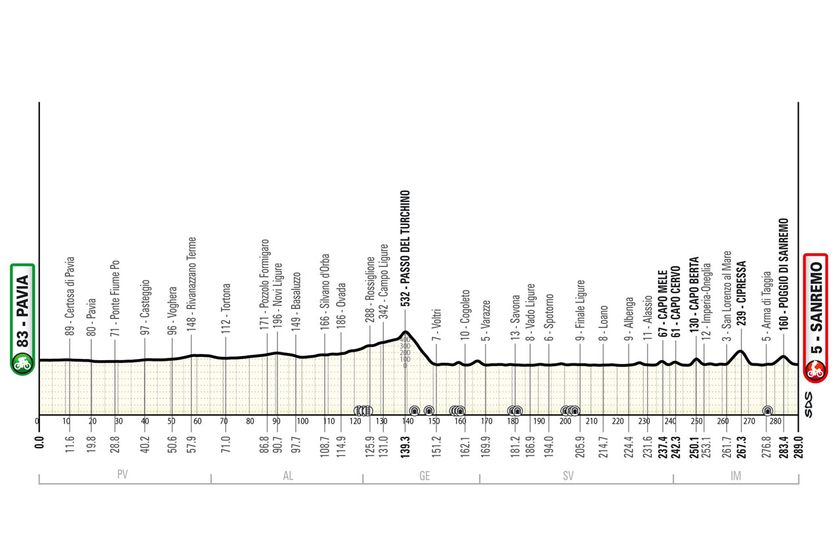2019 Vuelta a Espana offers eight mountaintop finishes, goes off road
Difficult mid-race stage in Andorra could be decisive

The 2019 Vuelta a España will trim back on its trademark summit finishes but the route remains just as mountainous as in previous years. To add to the challenge, the peloton will be treated to an unprecedented section of four kilometres of off-road racing.
More 2019 Vuelta a Espana route details leaked
2020 Vuelta a Espana to begin in the Netherlands with team time trial
Vuelta a Espana rumoured to return to more traditional route in 2019
Vuelta a Espana introduces young rider jersey in 2019
Andorra stage offers crucial climbing test in 2019 Vuelta a Espana
Stars align for Vuelta a Espana route presentation - Gallery
Eight summit finishes is one less than in 2018. But there are four of them in an unusually hard first week, culminating in a brutually difficult stage in Andorra - which has that off-road section, just before the final mountain ascent, too - to keep the climbers satisfied.
In comparison, the race’s one medium-length individual time trial in Pau, France at the start of week two is unlikely to intimidate the out-and-out mountain specialists.
Unveiled on Wednesday evening in the south-easterly coastal city of Alicante, close to where it will start next August 24th the 2019 Vuelta a España route draws a large anti-clockwise semi-circle north and west up through Catalonia, Andorra, France, the Basque Country, Cantabria and Asturias.
The final, comparatively easy, third week then takes the Vuelta south towards the sierras of Avila in western Spain, with a short transfer returning the race to Madrid for a final sprint stage on September 15th.
The Vuelta will notably avoid all of the south of Spain for the first time in several years, but the summer heat will likely prove, as ever, a major factor, particularly in the first week on Spain’s souther-easterly coastline and the third week in Spain’s sunbaked central sierras.
And whilst the climbers will likely be more than satisfied with the return of the Pyrenees and the Picos de Europa in northern Spain, the sprinters have an unusually high ration of opportunities, too with at least seven flat stages favouring the fastmen. Only the breakaway specialists will have limited opportunities to shine.
Get The Leadout Newsletter
The latest race content, interviews, features, reviews and expert buying guides, direct to your inbox!
The 2019 Vuelta kicks off with a flat, fairly lengthy, team time trial around the saltmarshes of Torrevieja near Alicante to establish the race’s first leader. But after a further two mass start stages round the Alicante region - the first, to Calpe, could well pare down the bunch to 70 or 80 riders - stage five sees the Vuelta dive inland to the remote Alto de Javalembre climb in the remote region of Teruel, and its first summit finish.
A single 12 kilometre climb, averaging seven percent, Javalembre should provide a more serious sort-out than the Vuelta’s usual first uphill finish. The climbs comes two days before the short but ultra-difficult Mas de la Costa, as well.
Mas de la Costa is just four kilometres long but given its steepness and technical difficulty, there is a good reason why ’Hell Starts Here’ graffiti was daubed repeatedly at its foot when the Vuelta last tackled this ascent back in 2016.
By far the most difficult stage of the first week, and arguably the whole race, is saved for the Vuelta’s return to Andorra on stage nine, a year after Simon Yates (Mitchelton-Scott) sealed his overall victory there in 2018.
Just 100 kilometres long and featuring the Ordino and the Col de la Gallina climbs in the first part, the final segment of the Andorra stage officially consists of three climbs, two second categories and the Cortals D’Encamp first category summit finish.
But with so little distance between them, and a four kilometre segment of off-road racing immediately preceding the final ascent of Cortals d’Encamp, the riders will have to tackle nearly 22 kilometres of almost continuous climbing, in a memorably tough finish.
After the race’s one day in the Pyrenees, the scene shifts quickly to Pau, a regular feature on Tour de France routes but never previously visited by the Vuelta. A medium-length time trial on rolling terrain could - finally - see the time triallists briefly regain some kind of impact on the race.
However, the next trio of mountain top finishes, spread over four stages between Cantabria and Asturias at the end of the second week, could well decide the race.
Los Machucos narrow, painfully steep slopes, revisited in 2019 on stage 13, witnessed one of the few occasions when 2017 Vuelta winner Chris Froome (Sky) found himself on the back foot that year. But neither of the second week’s other two summit finishes, both in Asturias Pico de Europa mountain ranges. are remotely familiar terrain.
The the Alto del Acebo, on stage 15, has often been used in the Vuelta a Asturias, but never before in the Vuelta a España. Furthermore, race route designer Fernando Escartin says Spain’s Grand Tour will use a completely unprecedented final ascent to the Acebo summit. La Cubilla, which concludes stage 16, is an old favourite amongst local cyclotourists, but its grinding 20 kilometre-long ascent at the end of two exhausting weeks, will likely not prove so popular with the Vuelta’s peloton
On paper, the third and final segment of the 2019 Vuelta, after a fortnight of fireworks, looks far less challenging, with three sprint stages in five days. There is only one summit finish, on the final Saturday and on a third category climb deep in the sierras of western Spain, whilst only one day, stage 18, features a no-holds-barred incursion into the mountains just west of Madrid.
However, given the events in the 2015 Vuelta a España, where Fabio Aru managed to outpower Tom Dumoulin on this very same terrain near Madrid, nobody will be taking anything for granted until September 15th, and the race’s final run-in to the Spanish capital - its 50th in the Vuelta’s history, and as certain as ever to end in one last bunch sprint.
2019 Vuelta a España
Saturday, August 24: stage 1: Salinas de Torrevieja - Torrevieja 24 kms (TTT)
Sunday, August 25: stage 2: Benidorm - Calpe 193 kms
Monday, August 26: stage 3: Ibi - Alicante 186 kms
Tuesday, August 27: stage 4: Cullera - El Puig 177kms
Wednesday, August 28: stage 5: L’Eliana - Alto de Javalembre 165 kms
Thursday, August 29: stage 6: Mora de Rubielos - Ares del Maestrat 196.6kms
Friday, August 30: stage 7: Onda - Mas de la Costa 182kms
Saturday, August 31: stage 8: Valls - Igualada 168kms
Sunday, September 1: stage 9: Andorra la Vella - Cortals d’Encamp 96.8 kms
Monday, September 2: restday France
Tuesday, September 3: stage 10: Jurançon - Pau 36.1kms ITT
Wednesday, September 4: stage 11: Saint-Palais - Urdax 169kms
Thursday, September 5: stage 12: Circuito de Navarra - Bilbao 175kms
Friday, September 6: stage 13: Bilbao - Los Machucos 168kms
Saturday, September 7: stage 14: San Vicente de la Barquera - Oviedo 189kms
Sunday, September 8: stage 15: Tineo - Alto del Acebo 159kms
Monday, September 9: stage 16: Pravia - Alto de la Cubilla 155kms
Tuesday, September 10: rest day two
Wednesday, September 11: stage 17: Aranda del Duero - Guadalajara 199.7 kms
Thursday, September 12: stage 18: Colmenar Viejo - Becerril de la Sierra 180.9kms
Friday, September 13: stage 19: Avila - Toledo 163.4kms
Saturday, September 14: stage 20: Arenas de San Pedro - Plataforma de Gredos 189kms
Sunday, September 15: stage 21: Fuenlabrada - Madrid 105 kms
Alasdair Fotheringham has been reporting on cycling since 1991. He has covered every Tour de France since 1992 bar one, as well as numerous other bike races of all shapes and sizes, ranging from the Olympic Games in 2008 to the now sadly defunct Subida a Urkiola hill climb in Spain. As well as working for Cyclingnews, he has also written for The Independent, The Guardian, ProCycling, The Express and Reuters.
Most Popular






